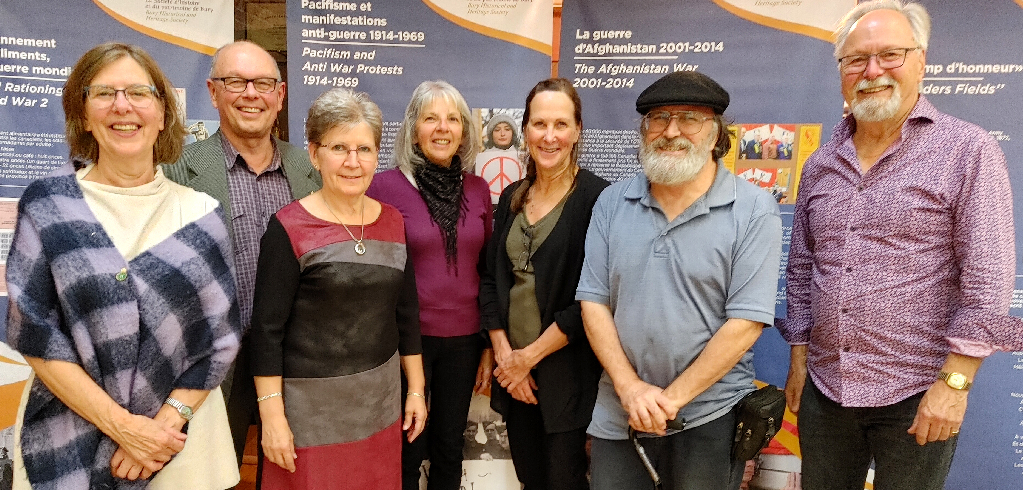The Military History Conference was organized by the Bury Historical and Heritage Society, whose Board of Directors are Praxède Lévesque Lapointe, President; Ed Pederson, President Emeritus; Diane Gagnon, Treasurer; Lise Dougherty; Dominique Lévesque; John Mackley, Archivist; Yvan Lapierre; (Absent: Joel Barter, Archivist).
Personal stories about Bury’s military past and a supper with recipes from World War II times: Both these experiences had pride of place in the Bury Armoury Community Centre last October 21. The occasion was a conference on the Military History of Bury and its surroundings, organized by the Bury Historical and Heritage Society and attended by about 100 persons.
Approaching the Centre, visitors drove between a fleet of 40 banners flying along Main Street, honouring Bury veterans. Inside, they perused historical banners and artefacts lining the walls, a selection of the military history displays that the Historical Society had mounted last spring. From 1 to 7:30 p.m., guests also heard musicians Paula Chiasson, Normand Breton, and Christian Nolet, and a series of speakers in both English and French. They also watched short videos, in both French and English, and enjoyed a banquet.
The opening ceremony featured bagpipe music with pipers Matthew Fowler and Sylvain Ross, and a welcome by the Society’s president, Praxède Lévesque Lapointe. She acknowledged the great sacrifices made by both military and civilians during past wars, and called for “empathy and prayers for peace” in the context of the current conflicts in our world.
The speakers were local witnesses who reported on their own experiences or stories passed down from their parents and grandparents. The conflicts included the Fenian raids of 1866 to 1870; the Boer War of 1899-1902; World War I, 1914-1918; World War II, 1939-1945; Battle of Hong Kong, 1941; Korea, 1950-1953; Afghanistan, 2001-2014; and various peacekeeping operations beginning in 1948.
According to an informative 36-page booklet on Bury’s Military History that the Society published in conjunction with the event, Bury has had a high participation rate in many wars, especially WWII.
“Per capita, Bury had the largest number of enlisted men of any town in Canada. In active service were 137 men and women, ten of whom paid the Supreme Sacrifice. Thirty-one were with the Royal Rifles at Hong Kong.”
Regimental Sergeant Major Justin Dahler of the Sherbrooke Hussars gave a detailed history of the regiment, dating from 1866 to today.
Then there were the “Ladies from Hell.” That’s what the enemies of Scottish forces called the dozens of pipers who led the Scottish forces, their bagpipes blaring, explained pipers Fowler and Ross.
Richard Gray, President of Bury’s Royal Canadian Legion, Branch 48, presented a detailed history of the group, and Edith Lévesque told about challenges faced by spouses and families of military personnel, and their changing roles during and after deployment abroad. “War accidentally contributed to feminism, with women contributing in many ways in the war effort,” said Lapointe.
Wearing her mother’s uniform, Wendy Olson spoke about her experiences as a young child, frequenting the Bury Armoury with her mother, Sergeant Kathleen (Kay) Olson. She described the uses of the building, and her mother’s role as a member of the Canadian Women’s Army Corps (CWAC) as secretary and accounting clerk for the Bury battalion. Sgt. Olsen was well known for her years as Bury Postmaster for Canada Post, and her daughter Wendy followed in her footsteps at the Post Office, where she now ranks Number 2 in seniority in Quebec.
One of the most touching presentations was by Martine Staehler, who grew up in Alsace-Lorraine, a region that changed hands many times between France and Germany. One of her uncles was conscripted by France; his brother, by Germany. That generation of soldiers called themselves the “malgré-nous” (despite ourselves); they had no choice in the matter.
Another gripping talk was by Larry Everett, who described the horrors endured by the soldiers who fought in the Battle of Hong Kong, and then detained as prisoners of war until the end of WWII. The audience listened in silence to the story of the horrors they endured. “Many of these veterans returned with what we now call PTSD,” said Everett.
Finally, guests were treated to a four-course banquet, prepared by Doris Bolduc, Diane Gagnon and Praxède Lévesque Lapointe. During the meal, she explained the story behind each dish.
“This was an excellent idea,” said guest Robert Alain. “Having a supper on a historical theme. And how it was carried out, too. It was excellent! Even if there was a little bit of cheating.”
Alain was referring to the main course, Woolton Pie, prepared with a sauce containing turkey meat. The original was a dish of boiled vegetables topped by mashed potatoes, but with no meat. It was recommended by the British Home office during a time of food shortages.
A Jerusalem Artichoke salad began the meal. The story of this root vegetable, said Lapointe, came from France during its occupation by Hitler’s forces.
“The Germans did not like it, and so did not confiscate it; the French therefore ate it in large quantities.”
Both these wartime dishes fell into disfavour after the war; people grew tired of them. Two products of the WWII period, however, carrot cake and Coaticook ice cream, remain favourites for many people today.
They were the banquet’s dessert; a sweet ending to a day full of emotions, both pride and sorrow.















